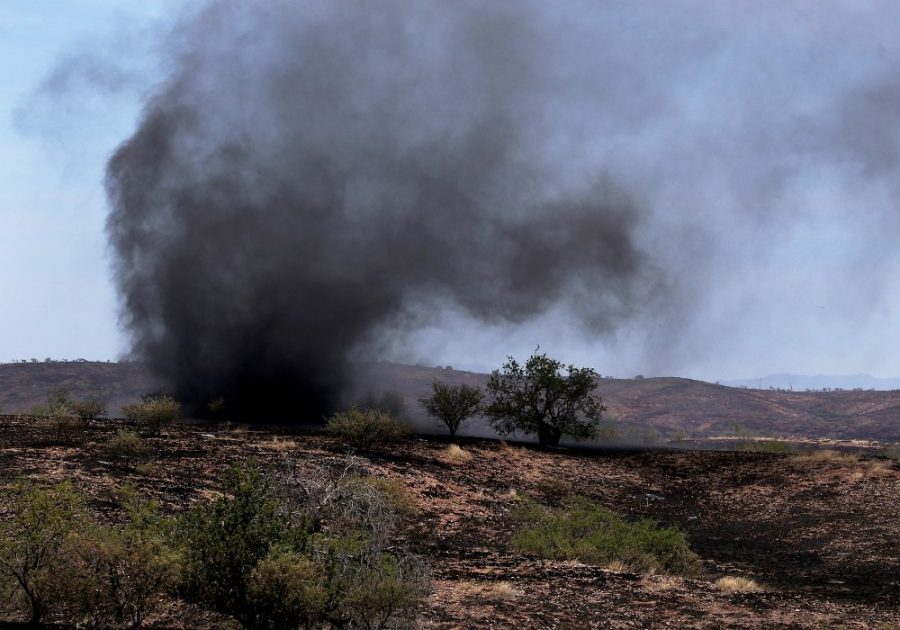The Burro Wildfire began its conquest of the Santa Catalina Mountain range on Friday, June 30. Since then, the fire has spread across over 27,000 acres in the eastern region of the Catalinas, causing the evacuation of Mount Lemmon residents and employees. Meanwhile, the Frye fire near Safford has burned nearly 50,000 acres of the Pinalenos mountain range.
Before the arrival of the monsoons on July 9th, the Burro fire was only 36% contained.
“Firefighters in the Catalinas and Pinalenos were waiting for the rains to come before they had a good chance to contain both the Burro and Frye,” said Chris Guiterman, dendrochronology research associate at the Laboratory of Tree-Ring Research. Now, thanks to monsoon rains over Mt. Lemmon and the Pinalenos, firefighters have the Burro fire 100% contained and the Frye contained at 98%.
These fires were propelled by varying weather patterns in southern Arizona. Tucson went without rainfall in April, May and June. Additionally, June was Tucson’s hottest month in recorded history, featuring a 15-day streak of over 105-degree temperatures.
“Fuels this year were well-supplied by a good monsoon season last year, which resulted in abundant grasses,” Guiterman said. “Heavier fuels like downed wood and small, live trees have accumulated over the last century due to a lack of fire in many areas.” The combination of abundant fuel, excessive heat and ongoing drought was a recipe for disaster.
While the Burro Fire has been the largest wildfire on the Catalinas in the past decade, it did not burn as much land as the Bullock fire of 2002 which covered over 30,000 acres, or the Aspen fire of 2003, which devastated over 80,000 acres on Mt. Lemmon.
RELATED: Sawmill Fire: Wildfire a hot topic for UA experts
Wildfires on the Santa Catalina’s tend to have a 10-15 year cycle according to Guiterman.
“It’s interesting ecologically to see that the Burro Fire burned through parts of the 2002 Bullock Fire, 15 years later,” Guiterman said. “Similarly, the Frye Fire burned through areas burned 13 years ago by the Nuttall Complex Fire. These are historically normal fire intervals, but came only after over 100 years without fire.”
The aftermath of the Bullock and Aspen forest fires is evident on the drive up the Catalina Highway to Mount Lemmon, but regrowth is also visible. The question remains how quickly the forest destroyed by the Burro fire will recover.
“You might see green grass and wildflowers within weeks or months in areas just burned by the Burro Fire. In a few years, you might not realize it had burned much at all,” Guiterman said.
However, it is uncertain whether or not the scorched lands will ever completely return to their former glory.
“Under historic conditions, the spruce-fir forest can return eventually, but climate change casts uncertainty on its long-term recovery,” Guiterman said.
On the morning of July 3rd, the residents of Summerhaven, tucked away near the top of Mount Lemmon, were evacuated as nearly 200 firefighters worked to protect the beautiful mountain town. Not until July 10th were residents and employees allowed to return to their homes and places of business.
It seems as though the wildlife displaced by the fire have taken up residence near Summerhaven, too. On July 13th Arizona Game and Fish issued a warning to residents and visitors of the town after eight bear sightings since July 11th.
RELATED: University research team identifies the impacts of forest death on other continents
While the fire itself is no longer a threat to nearby residents, what is left behind can be equally dangerous. “Another important aspect is the effect of intense rains on the burn areas, which can trigger flooding and debris flows. This is often the most worrisome aspect of a fire,” Guiterman said.
Just last week, a flash flood near Payson, Arizona killed nine people and left another missing. Much of the debris came from a recent wildfire in the Tonto National Forest.
While the cause of the Burro fire is still under investigation, only two realistic possibilities remain. One of those is human activity. Campfires or cigarette butts could have easily started such a fire. However, forest fires have been happening on Mt. Lemmon even before the widespread settlement of the Tucson valley, originating by way of dry lightning.
“In Tucson we have a lot of lightning and saw many fires start this year from passing thunderstorms before the real onset of the monsoon,” Guiterman said. “The ‘dry lightning’ storms start fires when there isn’t much moisture, so the fires are able to spread. This was the case for the Frye Fire in the Pinalenos.”
The monsoon now seems to be in full force, but since Catalina highway is reopening to the public, it’s still important for forest visitors to practice fire safety at all times. As Smokey the Bear says, “Only you can prevent forest fires.”
Follow Chandler Donald on Twitter.









